Number (sports)
.jpg)
In team sports, the number, often referred to as the uniform number, squad number, jersey number, shirt number, sweater number, or similar (with such naming differences varying by sport and region) is the number worn on a player's uniform, to identify and distinguish each player (and sometimes others, such as coaches and officials) from others wearing the same or similar uniforms. The number is typically displayed on the rear of the jersey, often accompanied by the surname. Sometimes it is also displayed on the front and/or sleeves, or on the player's shorts or headgear. It is used to identify the player to officials, other players, official scorers, and spectators; in some sports, it is also indicative of the player's position.
The International Federation of Football History and Statistics, an organization of association football historians, traces the origin of numbers to a 1911 Australian rules football match in Sydney,[1] although photographic evidence exists of numbers being used in Australia as early as May 1903.[2] Player numbers were used in a Queensland vs. New Zealand rugby match played on 17 July 1897, in Brisbane, Australia, as reported in the Brisbane Courier.[3]
Association football
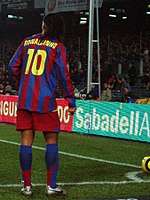
In association football, numbers were traditionally assigned based on a player's position or reputation on the field, with the starting 11 players wearing 1 to 11, and the substitutes wearing higher numbers. The goalkeeper would generally wear number 1, then defenders, midfield players and forwards in ascending order.
Numbers being assigned to each player in a squad was initiated for the 1954 World Cup, where each man in a country's 22-man squad wore a specific number between 1 and 22 for the duration of the tournament. In 1993, England's Football Association switched to persistent squad numbers, abandoning the mandatory use of 1–11 for the starting line-up. It became standard in the FA Premier League in the 1993–94 season, with names printed above the numbers. Most European top leagues adopted the system over the next five years.
It is common for players to change numbers within a club as their career progresses. For example, Cesc Fàbregas was first assigned the number 57 on arrival at Arsenal in 2003. On promotion to the first team squad he was switched to number 15 before inheriting his preferred number 4 following the departure of Patrick Vieira.
Very high numbers, the most common being 88, are often reserved and used as a placeholder, when a new player has been signed and played by the manager prior to having a formal squad number. However, in some countries these high numbers are well used, in some cases because the players preferred number is already taken or for other reasons. On joining A.C. Milan; Andriy Shevchenko, Ronaldinho and Mathieu Flamini all wore numbers reflecting the year of their birth (76, 80 & 84 respectively), because their preferred numbers were already being worn.
Australian rules football
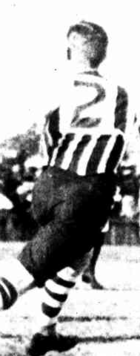
In Australian rules football, players traditionally wear numbers on the backs of their guernseys, although some competitions (the WAFL is one example) may feature teams who wear smaller numbers on the front, usually on one side of the chest. The number being worn is usually not relevant to the player's position on the ground, although occasionally a club will allocate the number 1 guernsey or an otherwise prestigious number to the team captain (such as the Richmond football club, which allocates number 17 to its team captain in honour of Jack Dyer, who wore that number with distinction). Port Adelaide assigns number 1 to the team captain. In these situations, it is usually customary for players who relinquish the captaincy to switch to another.
AFL clubs generally do not retire numbers (although Geelong temporarily retired the no. 5 between 1998 and 2005 after the retirement of Gary Ablett Sr.), but instead will often choose to give their more prestigious numbers to highly touted draftees or young up-and-coming players who are shown to have promise and may share certain traits with the previous wearer, such as position or playing style. For example, as of 2010, Michael Hurley inherited the no. 18 jumper left vacant by the retired Matthew Lloyd, effectively keeping the no. 18 in Essendon's goal-square for another era.
Sons of famous players will often take on their father's number, especially if they play at the same club. Sergio Silvagni and his son Stephen, for example, both wore number 1 for Carlton, with Stephen's son Jack later following suit. Matthew Scarlett wore his father John's no. 30 at Geelong. In contrast, some sons of famous players also prefer to take on other numbers in the hopes that it will reduce the burden of having to fulfill high expectations. Notable examples of this are Gary Ablett Jr. at Geelong (who wore no. 29 instead of his father's no. 5) and Jobe Watson at Essendon, who passed up Tim's no. 32 in favour of no. 4.
Clubs will often feature retiring champions "passing on" their famous guernsey numbers to the chosen successors, usually in ceremonial fashion, such as a club function or press conference.
The highest number worn in a VFL/AFL game is number 65 by Andrew Witts of Collingwood for seven games in 1985. With the demise of Reserves and Under 19's teams and, consequently, smaller club playing lists, it is unlikely that any player will play AFL-level football wearing so high a number again.
American football
NFL
The NFL has used uniform numbers since its inception; through the 1940s, there was no standard numbering system, and teams were free to number their players however they wanted. An informal tradition had arisen by that point that was similar to the modern system; when the All-America Football Conference, which used a radically different numbering scheme, merged with the NFL in 1950, the resulting confusion forced the merged league to impose a mandatory system of assignment of jersey numbers in 1952.[5] This system was updated and made more rigid in 1973, and has been modified slightly since then.[6] Numbers are always worn on the front and back of a player's jersey, and so-called "TV numbers" are worn on either the sleeve or shoulder. The Cincinnati Bengals were the last NFL team to wear jerseys without TV numbers on a regular basis in 1980, though since then several NFL teams have worn throwback uniforms without them, as their jersey designs predated the introduction of TV numbers. Players' last names, however, are required on all uniforms, even throwbacks which predate the last name rule. Since 2008, TV numbers have not been mandatory under NFL rules.
Some uniforms also feature numbers either on the front, back, or sides of the helmet (in pro football, these were most prominently worn on the San Diego Chargers "powder-blue" uniforms). Players have often asked the NFL for an exception to the numbering rule; with very few exceptions (see, for example, Keyshawn Johnson), these requests are almost always denied.
Below is the numbering system established by the NFL. It has been primarily unchanged since 1973, though small changes have been made on occasion since then, including opening up the 10-19 range for wide receivers in 2004,[7] and opening 40-49 up to linebackers in 2015, with the latter decree being named the "Brian Bosworth rule", who wanted to wear 44, but was ordered to change it to 55.[8] In the same year, numbers 50-59 were opened to defensive linemen; the first benefactor was Jerry Hughes.
- 1–9: quarterbacks, kickers, and punters
- 10–19: quarterbacks, kickers, punters, and wide receivers
- 20–39: running backs and defensive backs
- 40–49: running backs, defensive backs, linebackers, and tight ends
- 50–59: linebackers, defensive linemen, and centers
- 60–79: offensive linemen and defensive linemen
- 80–89: wide receivers and tight ends
- 90–99: linebackers and defensive linemen
Numbers 0 and 00 are no longer allowed, but they were issued in the NFL before the number standardization in 1973. George Plimpton wore 0 during a brief preseason stint as quarterback for the Detroit Lions. Jim Otto ("aught-oh") wore number "00" during most of his career with the Oakland Raiders. Wide receiver Ken Burrough of the Houston Oilers also wore "00" during his NFL career in the 1970s.
This NFL numbering system is based on a player's primary position. Any player wearing any number may play at any position at any time (though players wearing numbers 50–79 or 90-99 must let the referee know that they are playing out of position by reporting as an "ineligible number in an eligible position"). It is not uncommon for running backs to line up at wide receiver on certain plays, or to have a lineman or linebacker play at fullback or tight end in short yardage situations. If a player changes primary positions, he is not required to change his number unless he changes from an eligible position to an ineligible one or vice versa. In preseason games, when teams have expanded rosters, players may wear numbers that are outside of the above rules. When the final 53-player roster is established, they are reissued numbers within the above guidelines.
College and high school
In college football and high school football, a less rigid numbering system is employed. The only rule is that members of the offensive line (centers, guards, and tackles) that play in ineligible positions (those that may not receive forward passes) must wear numbers between 50 and 79. Informally, certain conventions still hold, and players often wear numbers in the ranges similar to their NFL counterparts; though the lowest numbers are often the highest prestige, and thus are often worn by players at any position. Kickers and punters are frequently numbered in the 40's or 90's, which are the least in-demand numbers on a college roster. The increased flexibility in numbering of NCAA rosters is needed because NCAA rules allow 85 scolarship players and rosters of over 100 players total; thus teams would frequently exhaust the available numbers for a position under the NFL rules.
One oddity of college football is that the same squad number can be shared by two (or more) players, e.g., an offensive and a defensive player. Usually one of the players is a reserve who rarely plays but there are exceptions: In the 2009 and 2010 seasons, that same number (5) was worn by South Carolina starting quarterback Stephen Garcia and starting cornerback Stephon Gilmore. Gilmore was also used as a wildcat quarterback in games against Clemson in 2009 and Southern Miss in 2010. The player change, since both players wore the same number, caused some confusion among opposing defenses, but was legal, since both players were not on the field at the same time. In 2012, the No. 5 was worn by two Notre Dame starters—quarterback Everett Golson and linebacker Manti Te'o.
Baseball
In baseball, players generally wear large numbers on the back of their jersey. Some jerseys may also feature smaller numerals in other locations, such as on the sleeves, pants, or front of the shirt. The purpose of numerals in baseball is to allow for easy identification of players. Some players have been so associated with specific numbers that their jersey number has been officially "retired". The first team to retire a number was the New York Yankees, who retired Lou Gehrig's #4 in 1939.
In the early years of baseball, teams did not wear uniform numbers. Teams experimented with uniform numbers during the first two decades of the 20th century, with the first Major League team to use them being the 1916 Cleveland Indians which used them for a few weeks before abandoning the experiment. Again in 1923, the St. Louis Cardinals tried out uniforms with small numbers on the sleeves, but the players did not like them, and they were removed. For the 1929 Major League Baseball season both the New York Yankees and Cleveland Indians put numbers on their jerseys, the first two teams to do so, beginning a trend that was completed by 1937, when the Philadelphia Athletics became the last team to permanently add numbers to their jerseys.[9][10]
There is no system for numbering players in baseball, though in the very early years some teams did employ their own systems. The 1929 New York Yankees handed out uniform numbers based on a player's position in the batting order; which is why Babe Ruth and Lou Gehrig wore their famous numbers 3 and 4; they batted third and fourth respectively that season. Numbers 1–8 were assigned to the regular starters at their respective batting order positions, numbers 9 and 10 were assigned to the Yankees two backup catchers,[11] while pitchers and backup fielders were assigned higher numbers.[12] Today there is no rhyme or reason to a player's uniform number, players may pick their own number for personal reasons, or accept a number assigned by the team.
Catcher Benito Santiago is the only major league baseball player (or any major professional sportsman) known to have worn a leading zero; Santiago wore the number 09 between 1991 and 1994 in an effort to make his uniform more comfortable.[13] Eddie Gaedel, the midget at the center of an infamous stunt by Bill Veeck's St. Louis Browns, is the only known major leaguer to have worn a fraction (1⁄8, which he had borrowed from the Browns' batboy) as his jersey number.
Canadian football
Canadian football follows the same general rules as American football, with some minor exceptions. In the original numbering system, offensive linemen wore numbers from 40–69 and numbers 70–79 were allocated to receivers. A rules change in 2008 switched numbers 40–49 from offensive linemen to eligible receivers. Any eligible player, whether he is a quarterback, running back, receiver, or a kicker, can wear any eligible number. Doug Flutie wore his Boston College number of 22 when he played quarterback for the BC Lions and No. 20 for the Calgary Stampeders. Currently, numbers 1–49 and 70–89 are eligible while 50–69 are not. Numbers 90–99 are generally worn on defense although in the early days of the Canadian Football League, 90s were common on offense. The number 0 is also allowed in the CFL. A defensive player can wear any number he chooses, regardless of the position he plays.
Rugby league
In rugby league each of the thirteen positions on the field traditionally has an assigned shirt number, for example fullback is "1". In recent times squad numbering has been used for marketing purposes in the Super League competition. In Super League each player is given a squad number for the whole season, the first choice starting line-up at the beginning of the season will usually be given shirts 1–13 but as interchanges (substitutions) occur during the game and injuries etcetera occur during the season, it is less likely that the number a player wears will match the position they are playing.
Furthermore, a growing number of teams in both Australia and England (such as South Sydney Rabbitohs and Warrington), as well as most major representative teams, have adopted the cricket custom of "club numbers", in which each player is given a unique number in the order of when he made his first senior appearance for a specific side. These numbers are typically small and embroidered above or below the club crest on a player's shirt.
Rugby union
When included in the starting line-up, a player's rugby shirt number usually determines their position. Numbers 1–8 are the 'forwards', and 9–15 the 'backs'. Rugby union even has a position named simply after the shirt normally worn by that player in the "Number 8" position. Several clubs (Leicester and Bristol particularly) used letters instead of numbers on shirts, although have now fallen into line with the rest of the clubs.
- 1- Loosehead Prop
- 2- Hooker
- 3- Tighthead Prop
- 4- Lock/Second Row
- 5- Lock/Second Row
- 6- Blindside flanker ("Openside" in South Africa)
- 7- Openside Flanker ("Blindside" in South Africa)
- 8- Number 8
- 9- Scrum half
- 10- Fly-half
- 11- Left winger
- 12- Inside Centre
- 13- Outside Centre
- 14- Right winger
- 15- Full-back
Gaelic Games
In Gaelic football, hurling and camogie, the goal keeper generally wears the number 1 shirt, and the rest of the starting team wears numbers 2–15, increasing from right to left and from defence to attack: substitutes' numbers start from 16.
Cricket
The 1995–96 World Series Cup in Australia saw the first use of shirt numbers in international cricket, with most players assigned their number and some players getting to choose their number, most notably Shane Warne wearing 23 as it was his number when he played junior Aussie Rules for St Kilda Football Club. Other countries soon adopted the practice, although players would typically have different numbers for each tournament, and it was several years later that players would consistently wear the same number year-round. Ricky Ponting (14) still uses the same number as in that initial season.[14]
Player numbering was first used in the Cricket World Cup in 1999, where the captains wore the number 1 jersey and the rest of the squad was numbered between 2 and 15. An exception was that South African captain Hansie Cronje retained his usual number 5 with opener Gary Kirsten wearing the number 1 which he had also done previously.
Shirt numbers no longer remain exclusive to the short forms of the game, and navy blue numbers are now used on the playing whites in the Sheffield Shield to aid spectators in distinguishing players. However, a recent fashion that has been taken up by several nations is the process of giving a player making his Test debut an appearance number, along with his Test cap, for reasons of historical continuity. The number represents how many players have made their Test debuts including the one wearing it. If two or more players make their debut in the same match, they are given numbers alphabetically based on surname. For example, Thomas Armitage is Test player Number 1 for England. He made his debut in the very first Test Match, against Australia, on 15 March 1877, and was first in alphabetical order on England's team. Mason Crane made his debut for England on 4 January 2018 against Australia; his number is 683. These numbers can be found on a player's Test uniform, but it is always in discreet small type on the front, and never displayed prominently.
Basketball
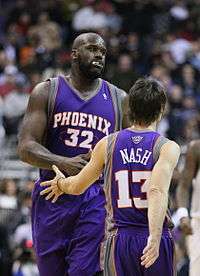
American basketball leagues at all levels traditionally use single and double digits between 0 and 5 (i.e. 0, 00, 1–5, 10–15, 20–25, 30–35, 40–45, and 50–55). The NCAA and most amateur competitions mandate that only these numbers be used. This eases non-verbal communication between referees, who use fingers to denote a player's number, and the official scorer. In college basketball, single-digit players' numbers are officially recorded as having a leading zero. Teams can have either a "0" or "00", but they cannot have both.[15]
The rule about "0" and "00" also applies to the NBA.[16] In 2000, Utah Jazz center Greg Ostertag changed from "00" to "39" so Olden Polynice could wear No. 0 and in 2003, Washington Wizards center Brendan Haywood switched from No. 00 to No. 33 so Gilbert Arenas (who had the nickname "Agent Zero" already at this point) could wear #0. However, during the 2015–16 season, the Denver Nuggets played with two players wearing both 0 and 00 (Emmanuel Mudiay and Darrell Arthur respectively), with the Cleveland Cavaliers (Kevin Love and Chris Andersen respectively) and Indiana Pacers (C. J. Miles and Aaron Brooks respectively) continuing the trend the following season.
The National Basketball Association has always allowed other numbers between 0 and 99, but use of digits 6 through 9 is less common than 0 through 5 since most players tend to keep the numbers that they had previously worn in college. However, with the increase in the number of international players, and other players who have been on national (FIBA) teams who change NBA teams and cannot keep their number with the previous team because another player has worn it or is retired, players have adopted such higher numbers (Patrick Ewing with No. 6 in Orlando). When Michael Jordan retired in 1993, the Chicago Bulls retired his 23; when he came out of retirement he chose to wear 45 until, during the 1995 NBA post-season, he went back to his familiar 23. Also, players cannot change numbers midseason, but they used to be able to (Andre Iguodala and Antoine Wright changed from No. 4 and No. 15 to No. 9 and No. 21 for Chris Webber and Vince Carter, respectively). Since Kelenna Azubuike was inactive all season, Carmelo Anthony was able to wear Azubuike's No. 7 when traded to the Knicks in 2011, but since Rodney Stuckey was active, Allen Iverson could not wear No. 3 when traded to the Pistons in 2009. (Anthony would not have been able to wear his normal No. 15 anyway and would have had to trade jerseys; the Knicks have retired the jersey number.)
Up to 2014, players in FIBA-organized competitions for national teams, including the Olympic Games, World Cup and Women's World Championship, had to wear numbers from 4 to 15. Under FIBA rules, national federations could also allow any numbers with a maximum of 2 digits for their own competitions; this rule also applied in transnational club competitions, most notably the EuroLeague.[17] At present, players are allowed any numbers from 1 to 99, additionally 0 and 00.[18]
Handball
In handball the number has to be at least 20 cm high in the back and 10 cm in the front.
According to the International Handball Federation the numbers between 1 and 99 should be used.[19]
The goalkeeper has often the number 12 or 1 also common is the number 16.[20]
The field player has often the other numbers between 1 and 20. Sometimes the players has also the last two digits of the year of their birth.
Ice hockey

The first group to use numbers on ice hockey players' uniforms is a matter of some debate. The Pacific Coast Hockey Association is sometimes credited with being the first to use numbered sweaters, but the National Hockey Association, the predecessor of the National Hockey League, is known to have required its players to wear numbered armbands beginning with the 1911–12 season, which may have come before that.[21] The Patrick brothers who founded the PCHA put numbers on players' backs so they could sell programs in which the players were listed by their numbers.[22] To start the 1977–78 season, the NHL placed into effect a rule that also required sweaters to display the names of the players wearing them, but Toronto Maple Leafs owner Harold Ballard initially refused to abide by it, fearing that he would not be able to sell programs at his team's games. The NHL responded by threatening to levy a fine on the team in February 1978, so Ballard started having names put on the jerseys but made them the same color as the background they were on, which for the team's road jerseys was blue. The League threatened further sanctions, and despite playing more than one game with their "unreadable" sweaters, Ballard's Maple Leafs finally complied in earnest by making the blue jerseys' letters white.[21]
The very first jersey number to be retired in professional sports was that of an NHL player - Ace Bailey, whose #6 was retired by the Toronto Maple Leafs in 1934 following a career-ending fight with Eddie Shore during a game against the Boston Bruins in 1933. Shore injured Bailey under the mistaken impression that Bailey had hip-checked him when it was actually fellow Maple Leaf Rod Horner. To aid Bailey, the NHL hosted a benefit game between the Maple Leafs and an all-star team, at which Maple Leafs owner Conn Smythe retired his number.[23]
Numbers used in the National Hockey League
Historically, starting NHL goaltenders wore number 1. Popular belief holds that this was because the goaltender was the first player on the rink from the perspective of one standing in front of the net; this is also believed to be why replacement goaltenders would also wear the number. Further use of the number 1 among goaltenders can be attributed to adherence to tradition.[24]
Over time, the number 1 became less common among goaltenders, with only seven using it as of December 2016. One reason was that goaltenders increasingly followed the example set by the Toronto Maple Leafs' Terry Sawchuk and the Montreal Canadiens' Patrick Roy after the NHL mandated that each team have two goaltenders in every game. In 1964, Sawchuk joined the Maple Leafs wearing 24 as the number 1 was already being used, but switched to 30, whereas Roy donned 33 as his team already had a player with the number 30, starting a trend of goaltenders using numbers in the 30s. Furthermore, seven franchises have retired the number 1—six in honor of players, and the Minnesota Wild in honor of its fanbase—making it unavailable. As a result, fewer goalies have chosen the traditional number 1 and instead have opted for more distinctive numbers, or numbers of their favourite goalies. Notable examples include Corey Crawford wearing 50 for the Chicago Blackhawks, Braden Holtby wearing 70 for the Washington Capitals, Sergei Bobrovsky wearing 72 for the Columbus Blue Jackets, and Andrei Vasilevskiy wearing 88 for the Tampa Bay Lightning.[24]
The NHL no longer permits the use of 0 or 00 as the League's database cannot list players with such numbers,[24] and in 2000 the League retired the number 99 for all member teams in honor of Wayne Gretzky.[25] The last number to go unused in the NHL was 84, and Canadiens forward Guillaume Latendresse became the first to wear it at the start of the 2006-07 season.[26]
Auto racing
In most auto racing leagues, cars are assigned numbers. The configuration of stock cars, however, makes the numbers much more prominent. (Aerodynamic open-wheel cars don't have nearly the amount of flat surface that a stock car has.) Numbers are often synonymous with the drivers that carry them. Dale Earnhardt, Sr. is associated with the number 3 (although that number is actually associated more with its owner, Richard Childress, who has taken the number out of reserve for his grandson Austin Dillon, first in the Camping World Truck Series, then in the Nationwide Series, and finally in the Cup Series beginning in 2014), while Richard Petty is associated with Number 43, Wood Brothers Racing with Number 21, and Jeff Gordon to the Number 24.
NASCAR
In NASCAR, numbers are assigned to owners and not specific drivers. Drivers that spend a long time on a single race team often keep their numbers as long as they drive for the same owners. When drivers change teams, however, they take a new number that is owned by that team. Jeff Burton, for example, raced for three different teams between 1994 and 2013, and had four different numbers in that time. In 1994 and 1995 he raced the Number 8 car, then owned by the Stavola Brothers. From 1996 to mid-2004 he raced for Roush Racing, and drove the Number 99 car. After leaving Roush Racing for Richard Childress Racing, he changed to car Number 30 (for the rest of the 2004 season) and drove Number 31 (also an RCR car) from 2005 to 2013. The Number 99 car he used to drive for Roush was driven by Carl Edwards from 2004 to 2014. When Dale Earnhardt Jr., having raced under Number 8 at Cup-level moved from DEI to Hendrick Motorsports he attempted to take the number with him. When that failed Hendrick was able to secure the Number 88 from Robert Yates Racing.
Formula One
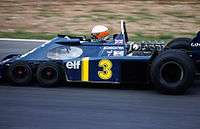
Formula One car numbers started to be permanently allocated for the whole season in 1974. Prior to this numbers were allocated on a race-by-race basis by individual organisers. From 1974 to the mid-1990s, the numbers 1 and 2 would be allocated to the reigning world champion and his teammate, swapping with the previous year's champions. Once numbers had been allocated, teams retained the same numbers from year to year, only exchanging for 1 and 2 when the drivers' World Championship was won. As a result, Ferrari are infamous for having carried 27 and 28 for many years (every season from 1980 to 1989, and then again from 1991 to 1995), these numbers having originally been allocated to new entrant Williams in 1977 and passed to Ferrari when Alan Jones replaced Jody Scheckter as World Champion after the 1980 season. Numbers were reallocated occasionally as teams departed and joined the series, but this scheme persisted until the late 1990s; one team, Tyrrell, kept the same numbers (3 and 4) throughout this period for every season between 1974 and 1995.
The system was changed again in 1996. From that point through 2013, numbers were assigned annually, first to the reigning World Champion driver (who received number 1) and then his team-mate (who received number 2); after that the numbers were assigned to constructors sequentially according to their position in the previous season's Constructors' Championship, so that numbers were allocated (if the reigning champion is not driving for the reigning constructor's champion team) from 3 and 4, 5 and 6, and so on (skipping 13 with the seventh-placed team using 14 and 15). The only stipulation was that the World Drivers' Champion was entitled to the number 1 car regardless of the constructor's results; this was relevant when the winning driver's team failed to win the Constructors Championship, or if the winning driver changed teams after winning the championship—for example, when Damon Hill moved to the Arrows team for the 1997 season. This situation happened again in 2007 when 2006 champion Fernando Alonso left Renault to join McLaren, earning him and his rookie teammate, Lewis Hamilton, the numbers 1 and 2; and again in 2010 when Jenson Button moved to McLaren from Brawn GP.

If a driver wins the World Championship but does not defend his title the following season, tradition dictates that the racing number 1 is not allocated; the reigning World Champion constructor then receives numbers 0 and 2. Damon Hill received car number 0 in 1993 due to Nigel Mansell's move to the CART PPG Indy Car World Series in the U.S., and again in 1994, this time due to Alain Prost's retirement. This tradition has not always been in place; Ronnie Peterson received number 1 in the 1974; although he did not win the championship the previous year, due to Jackie Stewart's retirement, his Lotus team was allowed to keep Number 1 as they had won the constructors' title.
The 2014 season was the first with a new system, in which drivers are assigned numbers for their entire careers. Under this system, similar to that used in MotoGP, drivers may choose any (available) number from 2 to 99, with number 1 reserved for the reigning Drivers' Champion. The champion's "regular" number is placed in reserve while that driver is using number 1, preventing other drivers from using that number. Since Jules Bianchi's fatal accident at Suzuka in 2014, Formula One has not issued Bianchi's number 17 as a mark of respect.[27]
A similar system is used in many European-style championships at national and international level; the champion receives number 1, and others are allocated either by a driver's placing in the previous season (third place the year before equates to race number 3) or by the team's placing in the Team/Constructor championship. If the championship driver does not return, the championship team will be allowed to use number 1.
IndyCar
During the USAC era of Indy car racing, it was traditional for the defending champion to carry No. 1 during the season. This rule had one exception; at the Indianapolis 500. The previous year's Indy 500 winner traditional utilized No. 1 in the Indy 500 that particular year. The defending national champion would have to select a different car number for Indy only, unless he happened to also be the defending Indy 500 winner, sometimes swapping numbers with the other affected driver. There were typical exceptions to the rule, as some defending champions decided against using No. 1, preferring instead to maintain their identity with their favorite number.
During the CART era, car numbers 1–12 were assigned based on the previous season's final points standings. Number 13 was not allowed, and starting in 1991, No. 14 was formally assigned to A. J. Foyt Enterprises. The remaining numbers 15–99 were generally allocated to the rest of the teams on first-come, first-served basis. Again at Indianapolis only, the No. 1 was set aside for use by the defending Indy 500 winner, if he so choose to use it, since it was a USAC-sanctioned race.
Some teams in the top 12 chose not to utilize their assigned number, instead preferring a personal favorite number. For example, Penske has used 2 and 3 since 1994. Also, Newman-Haas Racing exchanged the #2 with Walker Racing to get the #5 after Nigel Mansell joined the team in 1993, #5 having been his long-used number in Formula One. "Unused" numbers from 1–12 reverted to the general pool, and could be used by any of the remaining teams.
In the current IndyCar era, No. 1 is set aside for use by the previous season's championship entry. However, the majority of champions since 1998 have ignored the tradition. Teams and/or sponsors often request to keep their normal numbers in order to maintain their team identity, similar to NASCAR, and some drivers have used their car numbers in social media accounts. The 1998 IndyCar championship team was A. J. Foyt Enterprises, which kept the traditional #14, while Panther Racing kept the #4 identified with team minority owner Jim Harbaugh, who wore #4 for the majority of his NFL career (except for his year in Charlotte, where John Kasay wore that number, he wore Foyt's #14). In one case, at the 2012 Indianapolis 500, defending national champion Dario Franchitti, who normally used #10 and had the right to #1, chose to use #50 at that race for the 50-year anniversary of sponsor Target, which has been car owner Chip Ganassi's sponsor since 1990.
In the 2009 Firestone Indy 300, British driver Alex Lloyd used number 40202, in reference to the phone text message number of a campaign to donate to Susan G. Komen for the Cure.
Other sports
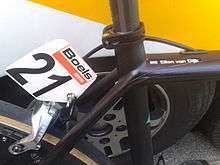
Other sports which feature players with numbered shirts, but where the number that may be worn is not relevant to the player's position and role are:
In water polo, players wear swim caps bearing a number. Under FINA rules, the starting goalkeeper wears Number 1, the substitute goalkeeper wears Number 13, and remaining players wear numbers 2 though 12. In road bicycle racing, numbers are assigned to cycling teams by race officials, meaning they change from race to race. Each team has numbers in the same group of ten, excluding multiples of ten, for example 11 through 19 or 21 through 29. If a race has squads of smaller than nine, each still uses numbers from the same group of ten, perhaps 31 through 36 where the next squad will have 41 through 46. Usually, but not always, the rider who wears a number ending in 1 is the squad's leader and the one who will try for a high overall placing. If the race's defending champion is in the field, he or she wears number 1.
In floorball all players are required to have number between 1–99 on their jersey, but goalies are the only players who can wear number 1.
Retired numbers
.jpg)
Retiring the uniform number of an athlete is an honor a team bestows on a player, usually after the player has left the team, retires from the game, or has died. Once a number is retired, no future player from the team may use that number, unless the player so-honored permits it. Such an honor may also be bestowed on players who had their careers ended due to serious injury. In some cases a number can be retired to honor someone other than a player, such as a manager, owner or a fan. For example, the Boston Celtics retired the squad number 1 in honor of the team's original owner Walter A. Brown.
See also
- Name (sports)
- Competition number in individual sports
References
- ↑ IFFHS Team. "Droll facts: 1911". www.iffhs.de. Dr. Alejandro Rodón (trans.). Retrieved 8 January 2010.

- ↑ "Maroons and Magpies fight for points in Sydney" (JPG). australianfootball.com. May 1903. Retrieved 4 August 2013.

- ↑ "Football - New Zealand v. Queensland" (scan). The Brisbane Courier. Vol. 54 (Issue 12, 828). 17 July 1897. pp. 6, col. 3. Retrieved 29 November 2014 – via trove.nla.gov.au.

- ↑ "PORT ADELAIDE V. GOLDFIELDS". Kalgoorlie Western Argus. XVI, (822). Western Australia. 9 August 1910. p. 23. Retrieved 5 November 2017 – via National Library of Australia.
- ↑ Packers.com » History » Record Book » Results And Rosters » All Time Jersey Numbers Archived 29 September 2007 at the Wayback Machine.
- ↑ Football 101 – Uniform Numbering System
- ↑ Alder, James. "Rules Changes for the '04 NFL Season". About.com. Retrieved 2 October 2014.
- ↑ http://profootballtalk.nbcsports.com/2015/03/25/nfl-passes-brian-bosworth-rule-linebackers-can-now-wear-jerseys-numbered-40-49/
- ↑ Lukas, Paul (24 April 2012). "Uni Watch: Who needs uniform numbers?". ESPN.com. Retrieved 2 October 2014.
- ↑ "National Baseball Hall of Fame - Dressed to the Nines - Parts of the Uniform". Exhibits.baseballhalloffame.org. Retrieved 2014-10-02.
- ↑ "Yankees Uniforms and Logos". mlb.com. Retrieved 2 October 2014.
- ↑ "1929 New York Yankees". Baseball-almanac.com. Retrieved 2 October 2014.
- ↑ Cubs select Benito Santiago, Jr. SB Nation (9 June 2010). Retrieved 22 September 2014. "insisted on wearing number ‘09’ because he claimed having the single digit in the middle of his jersey felt "weird" with the chest protector strap on top of it."
- ↑ Cricinfo – Australian ODI shirt numbers
- ↑ Schonbrun, Zach (31 March 2015), "Crunching the Numbers: College Basketball Players Can't Wear 6, 7, 8 or 9", The New York Times .
- ↑ http://friends.mavs.com/profiles/blogs/drew-gooden-q-amp-a
- ↑ Official Basketball Rules 2008, FIBA, Art. 4.3.2
- ↑ Official Basketball Rules 2014, FIBA, Art. 4.3.2
- ↑ "IX. Rules of the Game" (PDF; 2,34 MB). www.ihf.info. 2016-07-01. p. 16 §4:8. Archived (PDF) from the original on 2018-03-09. Retrieved 2018-03-09.
- ↑ Boysen, Stefan (2011-02-24). "Die Glückszahlen" [The lucky numbers]. Spiegel (in German). Archived from the original on 2018-03-09. Retrieved 2018-03-09.
- 1 2 DeLaere, Matt (17 August 2017). "What's in a Number?". Impressions. Retrieved 2 March 2018.
- ↑ "Vancouver brother sculpted game of hockey 100 years before Canucks vied for Cup". June 13, 2011. Retrieved July 7, 2018.
- ↑ Greene, Nick (7 November 2014). "Who Had the First Jersey Number to Be Retired in Sports?". Mental Floss. Retrieved 28 October 2017.
- 1 2 3 Pinchevsky, Tal (30 November 2016). "Why goalies are increasingly ditching traditional No. 1". ESPN. Retrieved 28 August 2017.
- ↑ "Perfect setting: Gretzky's number retired before All-Star Game". CNN Sports Illustrated. Associated Press. 6 February 2000. Archived from the original on 12 November 2013. Retrieved 9 June 2014.
- ↑ Cazaneuve, Brian (25 October 2006). "NHL's best by numbers". Sports Illustrated. Archived from the original on 5 November 2006. Retrieved 9 November 2017.
- ↑ Parkes, Ian (20 July 2015). "The FIA will retire Jules Bianchi's number 17 from Formula 1". Autosport.com. Haymarket Media. Archived from the original on 20 July 2015. Retrieved 20 July 2015.
External links
- English football's experiments with numbering
- Article in The Guardian about the Number 1 goalkeeper jersey
- Overcompetitive.com – tongue-in-cheek look at the traditions behind numbers 1 to 11 in football
- Baseball Hall of Fame, with uniform numbers
- Retired numbers for NFL franchises
- More than just a number? The importance of a squad number.